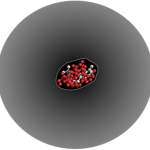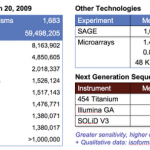Next Generation DNA sequencing
Scale, proportion, and quantity belong to one of the cross cutting concepts in the next generation science standards (NGSS). According to Volume 2 of the NGSS, "in engineering, no structure could be conceived much less constructed without the engineer's precise sense of scale." The authors go on to note that scale and proportion are best understood using the scientific practice of working with models.
When scientists and engineers work with these concepts at a molecular scale, new kinds of technologies can be created to advance our understanding of…
In our series on why $1000 genomes cost $2000, I raised the issue that the $1000 genome is a value based on simplistic calculations that do not account for the costs of confirming the results. Next, I discussed how errors are a natural occurrence of the many processing steps required to sequence DNA and why results need to be verified. In this and follow-on posts, I will discuss the four ways (oversampling, technical replicates, biological replicates, and cross-platform replicates) that results can be verified as recommended by Robasky et. al. [1].
The game Telephone teaches us how a…
Getting an accurate genome sequence requires that you collect the data at least twice argue Robasky, Lewis, and Church in their recent opinion piece in Nat. Rev. Genetics [1].
The DNA sequencing world kicked off 2014 with an audacious start. Andrew Pollack ran an article in the New York Times implying that 100,000 genomes will be the new norm in human genome sequencing projects [2]. The article focused on a collaboration between Regeneron and Geisinger Health in which they plan to sequence the exomes (the ~2% of the genome that encodes proteins and some non-coding RNA) of 100,000…
In simple Mendelian genetics, a single change in one gene can produce a large change in mortality. The National Human Genome Research Institute (NHGRI) will be funding genomics studies on Mendelian traits using a similar strategy.
NHGRI will fund a small number of centers, dominant centers you might say, and look for large changes. The sequencing centers that will benefit are the Broad Institute, Washington University, and Baylor College of Medicine. For the next four years, the big three will be dividing $86 million a year according to a press release from NHGRI. I'm not sure what algorithms…
For the past few days I've been avidly following Daniel MacArthur's tweets from the Personal Genome Conference at Cold Spring Harbor(@dgmacarthur #cshlpg).
The Personal Genomics tweets aren't just interesting because of the science, they're interesting because MacArthur and others have started to take on the conventional dogma in genetic ethics.
For years, there has been a strong message from the clinical genetics and genetics education community that genetic information is dangerous.
Unlike the other medical tests we're continually urged to get (mammograms, blood pressure readings, sugar…
I had the good fortune on Thursday to hear a fascinating talk on deep transcriptome analysis by Chris Mason, Assistant Professor, at the Institute for Computational Biomedicine at
Cornell University.
Several intriguing observations were presented during the talk. I'll present the key points first and then discuss the data.
These data concern the human transcriptome, and at least some of the results are supported by follow on studies with data from the pigmy tailed macaque.
Some of the most interesting points from Mason's talk were:
A large fraction of the existing genome…
These days, DNA sequencing happens in one of three ways.
In the early days of DNA sequencing (like the 80's), labs prepared their own samples, sequenced those samples, and analyzed their results. Some labs still do this.
Then, in the 90's, genome centers came along. Genome centers are like giant factories that manufacture sequence data. They have buildings, dedicated staff, and professional bioinformaticians who write programs and work with other factory members to get the data entered, analyzed, and shipped out to the databases. (You can learn more about this and go on a virtual tour in this…
You might think the coolest thing about the Next Generation DNA Sequencing technologies is that we can use them to sequence long-dead mammoths, entire populations of microbes, or bits of bone from Neanderthals.
But you would be wrong.
Sure, those are all cool things to do, but Next Generation DNA sequencing (or NGS for short) can give us answers to questions that are far, far more interesting.
With NGS, we can look at entire transcriptomes (!!) together with the proteins that make them and the DNA modifications that help regulate them. If we compare a cell to music, a genome sequence…
Last spring, I gave my first hands-on workshop in working with Next Generation Sequencing data at the Eighth Annual UT-ORNL-KBRIN Bioinformatics Summit at Fall Creek Falls State Park in Tennessee. The proceedings from that conference are now on-line at BMC Bioinformatics and it's fun to look back and reflect on all that I learned at the conference and all that's happened since.
Figure 1. Fall Creek Falls State Park, TN
When the conference took place, Geospiza had only just released new versions of GeneSifter Analysis Edition that could do gene expression analysis with Next Gen data.
Who…
A couple of years ago, I answered a reader's question about the cost of genome sequencing. One of my readers had asked why the cost of sequencing a human genome was so high. At that time, I used some of the prices advertised by core labs on the web and the reported coverage to estimate the cost of sequencing Craig Venter's genome. As you can imagine, the cost of sequencing has dropped quite a bit since then.
In 2007, Genome Technology reported the cost of sequencing Venter's genome was $70 million. Watson's genome at only $2 million, was a bargain.
Why was Watson's genome so cheap?
Even…
Watching the chIPs roll in,
then I watch them roll away again,
I'm just sitting on the DNA,
wasting time
(sung to the tune of "Sitting on the dock of the bay" by Otis Redding)
Hesselberth et.al. recently published a paper about digital genomic
footprinting that blew me away because it has so much potential. The authors used DNAse I and Next Generation DNA Sequencing to map every site in the yeast genome where a protein might be sitting.
Since I used to do similar kinds of experiments, albeit on a much, much smaller scale, this sort of publication boggles my mind. It's only recently that I've…
For the past few months, the shake-up that began with Next Generation DNA Sequencing has been forcing me to adjust to a whole new view of things going on inside of a cell. We've been learning things these past two years that are completely changing our understanding of the genome and how it works and it's clear we're never going back to the simple view we had before.
What's changed? The two most striking changes, to me at least, are the new views of the way the genome is put together and what the cell does with the information.
They just don't assemble chromosomes like they used to.
I used to…
Cofactor Genomics is offering to sequence a genome for a few classes for free using Next Generation DNA Sequencing technology (either Illumina GA or via AB SOLiD).
Quoting from their site:
Cofactor will ask course organizers for a 1 page description of how their ~700Mb sequencing project could be used as an effective teaching aid in their class. We will review and choose the best entries during the month of May. Those entries will be awarded a free sequencing project including project experimental design, sample QC, library construction, sequencing, and computational analysis. Those projects…
One of my favorite web 2.0 technologies is the webinar. When you work at a company and not a University, with constant seminars, it gets a bit harder to hop on a bus and travel across town to learn about new things. Webinars are a good way to fill that gap. I grab my coffee cup, put on my headphones, and I get to listen to someone tell me about their work for an hour and show slides over the web. It's nice.
Our company is even going to be involved in two webinars in the next two months. One of us is giving an Illumina webinar tomorrow on managing Next Generation Sequencing data. A…
It's a Solexa data directory.
I've held off on blogging about Next Generation Sequencing here, but now that one of my colleagues has started blogging about it, it seems like a good time to write a little about FinchTalk, our company blog.
We've decided that we can serve an educational role for people who are interested in Next Generation DNA Sequencing.
Certainly, FinchTalk is our company blog and it is a place where you can expect to read about our products. But, we've noticed that quite often, the sexy technologies and fancy graphs get the press and the practical aspects - how do…

